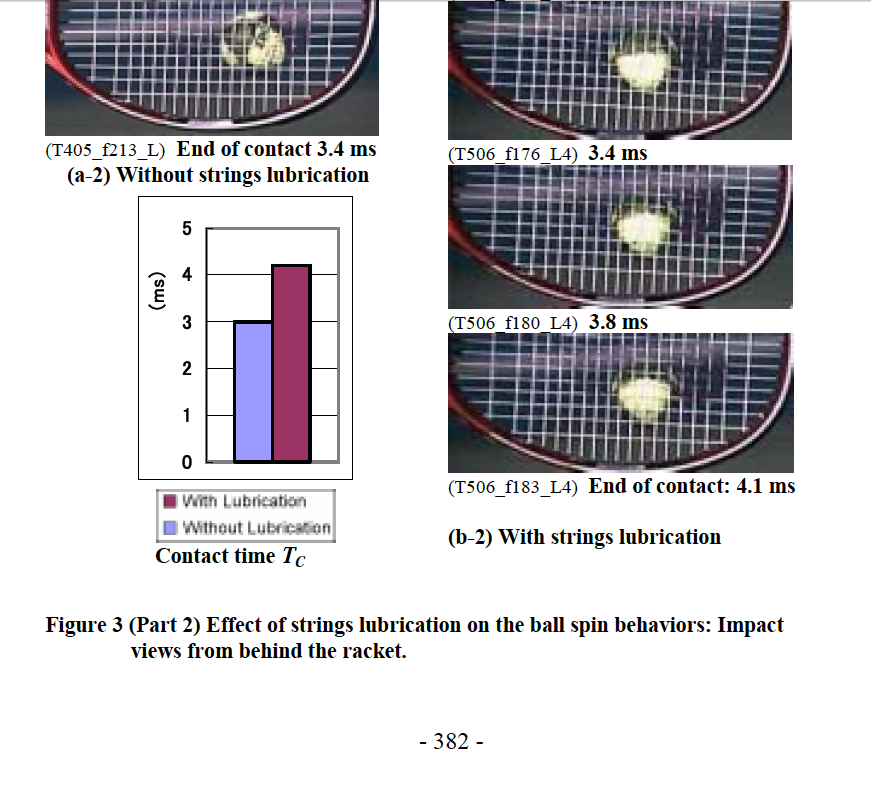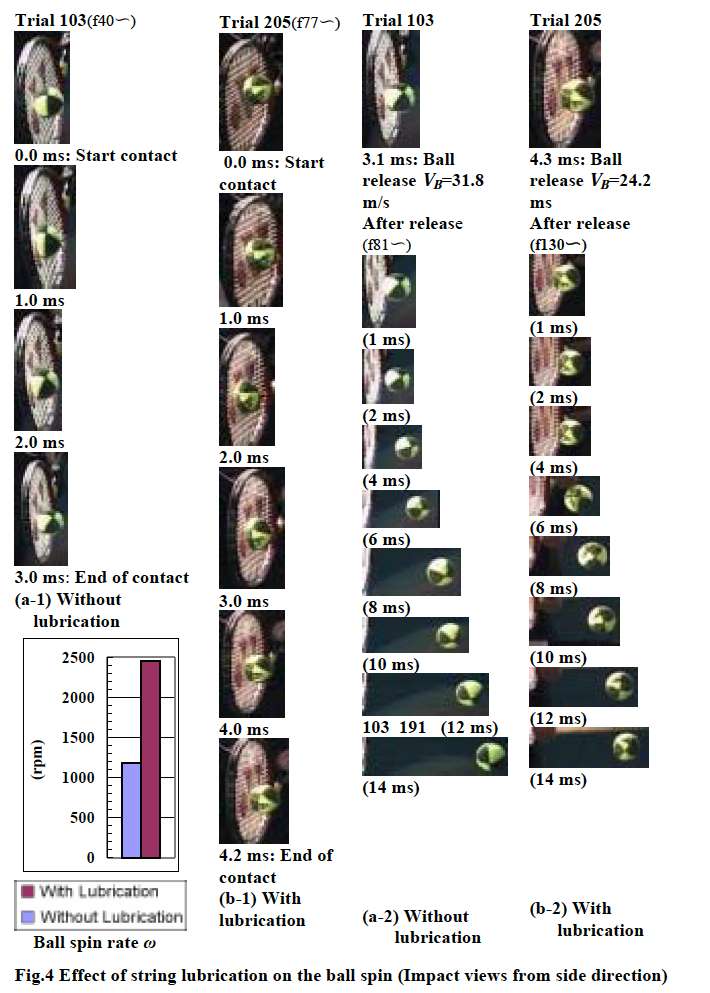No one has been able to explain why BP is wrong. He is saying that the snap back is not a big deal.
No, he is saying that snapback does not occur fast enough to impart additional topspin. This is false, and I explained why a page or more back. Main strings can produce additional topspin by snapping back, and most certainly do, depending on whether stringbed conditions and shot parameters are favorable for this to occur. This has been shown in numerous studies by three teams of researchers in three different countries. This is not something that people who have read these papers would debate. There are interesting questions about the conditions under which main string snapback-induced topspin occurs, but whether or not it can occur is not one of them. Four or five years ago, sure, we could argue about this. But not today. There has been so much research done on this in the past three or four years that ff you want to be educated on this topic there are at least ten papers that you need to read.
TWU seems to list it way down (my interpretation). It is not clear if the 200 RPM increase with the 99S (which also happened to me in the playtest) is due mostly to open string pattern or snap back. I know they are related to some degree, but open pattern can produce more spin due to other factors, also discussed in TWU.
It is quite clear to me that lateral string snapback is responsible for the additional spin generated by Wilson Spin Effect racquets - the direct spin boost that Wilson observed in the lab, in comparison to conventional string patterns. This paper explains:
http://twu.tennis-warehouse.com/learning_center/spinpatterns.php
You question this, and wonder whether it is, in fact, simply the open pattern responsible for the greater spin. Why would a very open pattern produce more topspin, if not by promoting a more efficient and powerful snapback of the main strings? By what other mechanism would a very open pattern produce more topspin?
And related to that, BP has pushed his notion that open patterns and copoly strings generate more spin because of increased ball/string friction. But consider,
the greatest increases seen in spin rates have been when lubrication has been applied to the strings! If copoly strings and open patterns increase spin through increased ball/string friction, why would lubricating the string increase spin? Clearly, applying a lubricant will decrease ball/string friction, and impede the ability of the ball to grip the strings. The answer is obvious: due to the interlaced nature of our stringbeds, which feature raised surfaces and holes in between for the ball to sink into, strings, even when lubricated, have plenty enough friction to grip the ball. The reason why lubrication increases spin is then also obvious: because it decreases inter-string friction and allows a freer and more energetic snapback of the main strings. And this is despite the fact that that lubrication has also decreased the friction between the ball and the strings!
Or, as the TW Prefessor wrote:
For the 16x19 pattern, the spin increased for every string — from 19–58%. Any adverse effects of a lesser ball-to-string coefficient of friction did not overcome the topspin facilitation due to lubrication. There is no pattern to the increase, whether by string type or use condition. Each string increased in spin as a function of its individual use and condition parameters. So we can't make any generalizations about what kind of percentage increases to expect by lubricating nylon, gut, or polyester as a class of materials compared to other classes. But it seems that we can say that in this type of high tension, dense pattern setup, each string type will experience a significant increase in spin. And further, the cause of the increase is due to greater lateral string movement by the mains and the resulting torque they create when they return to their original positions.
Note: It has been shown that at very extreme impact angles ball/string friction does becomes more important than interstring friction. Almost all impacts in tennis are between 10 and 30 degrees from perpendicular (30 being seen with steep swing angles). 40 degrees is about the limit that we see, with Nadal's heaviest forehands, for example. At 40 degrees and angles less than that, lubrication improves topspin. But at 60 degrees, which might be seen in some topspin lobs, maybe, lubrication causes the ball to slip off the strings, and so topspin is sharply reduced.
These results can be found in
this paper by researchers in England associated with the International Tennis Fedaration. You need to read the full text; the abstract is too short and could mislead. I was able to download it from this link recently for free, but for some reason I can't now. If anyone wants a copy, send me an email. This paper also concludes that main string snapback generates additional topspin, if interstring friction is low-enough, and especially if there is high incoming topspin, (because the spinning ball pushes the string sideways faster than if there is no incoming topspin.)
This paper also included experiments with nylon and copoly strings that were abraded with sandpaper, which should be of great interest to anyone following this. If increased ball/string friction were the mechanism responsible for copoly's spin-potential, we would expect to see increased spin from these roughened strings, especially with the very steep 40 and 60 degree impact angles the researchers used. At those extremely steep angles, the tendency will be for the ball to slip off, rather than to bite, the strings.
But, in fact, the opposite was observed: the roughened strings generated less spin than the unmolested ones, and much less than the lubricated ones!
Finally, Sureshs, you raise the question of how important snapback-generated spin is in the grand scheme of things. Numerous studies have shown that copoly strings generate between 10% and 25% more spin than multis and synguts. Is this significant?
BP, and others, have questioned whether the real importance of copoly is not this direct spin boost, but a technique-dependent effect related to copolys being "low-powered". This is a completely separate question from whether snapback increases spin. Among his other tricks, BP likes to slide from one argument to the next, which seems to serve his delusion that he's never wrong. If he doesn't admit that one argument is wrong, but simply changes to a new argument, he can continue to pretend that he's right. And it seems to me that he's retreated from "snapback doesn't happen fast enough to provide more spin" to "even if it does, that's not the main reason copolys provide so much spin on the court". This is a dirty trick, in my opinion, and serves to keep these arguments going around and around as long as people have time to waste on this guy.
But nevertheless, this question is interesting. The argument is an old one, and goes like this: copolys are "low-powered", so the player has to swing faster for the same depth. Swinging faster, as we all know, is the most effective way to generate more topspin. So we swing faster and instead of achieving depth we achieve more topspin, which drops the ball shallower in the court. So we swing even faster, generating even more topspin. We no longer hit long. Over time, players start to change their technique so that they can swing even faster, and steeper, producing even more topspin. This is a technique-dependent feedback loop, all enabled, or intiated, by copoly strings being "low-powered."
But are they "low-powered"? The last paper I linked to above also included rebound speeds. The researchers found that nylon strings produced rebound speeds about 2.5 mph faster than the copoly strings. 2.5 mph. Not much, really, it seems to me. In fact, if the shots start out on the same trajectory, those extra 2.5mph will only result in about 1.3 feet of extra depth.
In my opinion, it's much more likely that an additional 10-20% of direct spin boost provided by strings that snapback in time to provide it, would set up this spin-friendly feedback loop. That extra spin will get the ball dropping shallower in the court than a drop of 2.5 measly MPHs would, and also increase a player's confidence to hit harder and faster, further increasing the amount of spin he hits.
But that's just my opinion, although it's shared by some people who study these things.






